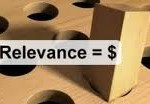 What did this last round of Super Bowl ads do for the brands who created them? In my opinion, not much—when you consider the colossal price tag of the ads compared to brand perception. This past year a 30-second spot cost $4M to air, not counting the costs for an agency to produce it.
What did this last round of Super Bowl ads do for the brands who created them? In my opinion, not much—when you consider the colossal price tag of the ads compared to brand perception. This past year a 30-second spot cost $4M to air, not counting the costs for an agency to produce it.
According to MediaLife, $1.85 billion was spent on these ads over the past 10 years, and all the while TV viewership has flattened. So who really benefits?
Well, the ad agencies benefit, because they get a lot of money for producing these commercials. Plus, it’s in their best interest to be funny and creative because they win awards when they do—and those awards bring them more business. However, just because an ad is creative or funny doesn’t mean it’s going to help the brand’s bottom line. So unfortunately for the Brand, this process has become quite counter (???) intuitive.
A case in point would be Allstate’s “Mayhem” ads. When you look at these elaborately produced pieces, are you thinking of Allstate all the way through the ad? Does it make you feel a need to find an Allstate agent? No. You’re thinking about what’s happening in the ad—which has little if nothing to do with your perception of Allstate as an insurance company. The Allstate branding only comes into play at the end—and it’s a complete disconnect with the rest of the ad. They certainly are entertaining (I love’em), have revived the career of the actor starring as “Mayhem,” earned the agency quite a few creative awards, made their job easy just continuing with the same theme (hey… it’s winning awards!)… and continues even as Allstate continues to lose market share. Way to go ![]()
If a company’s brand is its perception in the marketplace, then what does that kind of advertising do to build business? Not much. It shows they can produce an entertaining, action-packed commercial, but does it make you “feel” better, connected, or better informed about the insurance company?
Perhaps Allstate is jumping on the bandwagon because its competitors seem to do well in the space.
According to Joe Cahill’s On Business blog: “Allstate is losing customers to State Farm Insurance Cos., Geico and Progressive Corp., all of which spend heavily on television commercials and compete hard on price. Recent figures show Geico is close to unseating Allstate as the No. 2 auto insurer, behind Bloomington-based State Farm.”
Now why is Allstate losing ground, in spite of its heavy ad spend? There may be other things at play there besides advertising, but let’s take a look at Geico’s branding over the last several years. Geico’s “Gecko” commercials are much better at instilling brand awareness for auto insurance; they mention Geico throughout each piece and talk about the benefits of Geico insurance in real terms. People can identify with them. It’s brilliant advertising that does what it sets out to do—build brand awareness and get people to associate value to the name. The same thing can be said of Aflac. Who doesn’t associate Aflac with a white duck these days and more importantly with protecting you in case of being out of work due to injury? And it’s not just because it’s a duck—it’s the consistent messaging that made Aflac ads memorable and easy to associate with value. And Progressive, another upstart gaining ground build so much of it’s brand value, and consumer value into every marking piece… entertaining yes, but brand centric, absolutely.
The lesson here is that it’s not enough just to entertain consumers for the sake of entertainment, but to be strategic about your messaging so that value to the consumer is the main driver. Like Allstate’s “Mayhem,” award winning, entertaining, game changing for the actor, YES!… effective for the brand, I don’t think so! In my opinion, the millions it takes to air Mayhem ads would have been better spent seeking to cultivate better relationships with insurance consumers. It’s those relationships that drive revenue—not ads that have nothing to do with cementing value in the mind of the target audience.
-Originally posted at: http://www.tedrubin.com/blog/